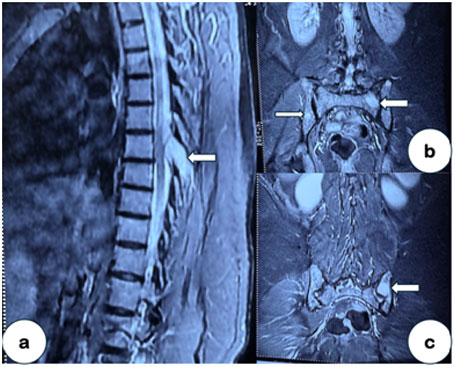Spot the diagnosis 2

M Madeshwaran MD, DM
Consultant Rheumatologist, Royal Care Hospital, Coimbatore, Tamil Nadu, India.
Case Description:
A 47-year-old female presented with low back pain of 8 months duration. She had more pain at night, disturbing her sleep, and also had pain on exertion during the day. She experienced back stiffness for 30 minutes upon waking up from bed. She had no peripheral joint symptoms, no skin lesions, no red eye or altered bowel habits. She had no fever or weight loss. Upon evaluation, she had an ESR of 90 mm/hour, with normal CRP and negative rheumatoid factor, anti-CCP, and antinuclear antibody. X-ray of the lumbosacral spine showed L5-S1 spondylolisthesis. Her liver function test revealed hypergammaglobulinemia (serum globulin of 6.8 mg/dl). Given night pain, an MRI of the pelvis with screening of the whole spine was ordered along with a blood investigation.
Images:

What is the likely diagnosis?
Answer:
Multiple Myeloma with well-defined edematous lesions in the pedicle and the sacroiliac joint.
Figure a: Involvement of the pedicle, being enlarged on indenting the spinal cord.
Figure b & c: Multiple well-defined edematous lesions in the sacral and iliac part of the sacroiliac joint.
Further evaluation: Given night pain, elevated ESR and hypergammaglobulinemia, serum protein electrophoresis was also requested along with MRI, and she had a positive ‘M’ band.
Message: ‘All that glitters is not gold’. Low back pain that disturbs sleep is a red flag. Edematous lesions in the sacroiliac joint are not always inflammatory, even when inflammatory markers are elevated. We should always consider the differential diagnosis for inflammatory back pain, if any atypical features are present (middle-aged female, elevated ESR and hypergammaglobulinemia).

